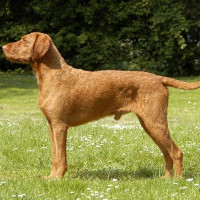Appearance of the German Wirehaired Pointing Vizsla
|
| The German Wirehaired Pointing Vizsla is considered a medium-sized dog. Their average height can range from 53.5 to 63.5 centimeters, with males being the tallest. Their eyes are always alert and oval-shaped. The ears of this hybrid are medium-sized, slightly flat and floppy, and tend to have a rounded V-shape towards the end. The head of this elegant, strong dog is domed and of medium length. The muzzle runs parallel to the head and is blunt. The body of the German Wirehaired Pointing Vizsla is strong, muscular and strongly built, with a deep, broad chest and very straight topline. Their legs are long and almost feline, and they are muscular and well balanced. The coat is often 2.5 to 5 centimeters long, with a softer, shorter undercoat and a denser, wiry outer coat. These dogs will have a very robust appearance, with more fur concentrated on the muzzle, eyebrows, belly, neck ears and chest area. |
Temperament of the German Wirehaired Pointing Vizsla
|
| The German Wirehaired Pointing Vizsla is an excellent sport animal because it is alert, quick to learn, obedient and has excellent stamina. They do well with children and other animals as long as there is adult supervision. When not out in the field hunting or retrieving, this hybrid is an excellent companion for a family home. They are gentle and people-pleasing. When meeting strangers, they should be friendly as they are not designed to be aggressive towards people. They can bark to alert their owners to a stranger, making them a relatively good watchdog. |
Needs and activities of the German Wirehaired Pointing Vizsla
|
| The German Wirehaired Pointing Vizsla is a very active dog, they need at least 60 to 120 minutes of daily physical activity, especially if they are under 12 months old. These dogs thrive in homes where they have the opportunity to run, swim, play with balls and play with other toys. These dogs are recommended for owners who lead active lives and are able to handle energetic breeds. They will do best in a home environment with plenty of room to play and a well-enclosed area where they can walk, stretch and explore several times a day. |
Maintenance of the German Wirehaired Pointing Vizsla
|
| The German Wirehaired Pointing Vizsla has a water- and weather-resistant coat, making it a relatively low-maintenance hybrid. You may simply need to brush dirt and loose fur from his coat once a week. Bathing should be done as needed, however, most owners choose to use a dry shampoo or damp cloth to clean the fur. As these dogs are always active and running, their nails tend to wear naturally. If your hybrid is older and less active, you may need to trim his nails every few weeks. As with all dogs, his ears need to be checked and cleaned regularly. Because this hybrid is a hunter and a lover of water, dirt and moisture can accumulate in the inner ear. If you brush his teeth several times a week, you may avoid additional dental appointments in the future. |









 English (United Kingdom)
English (United Kingdom)